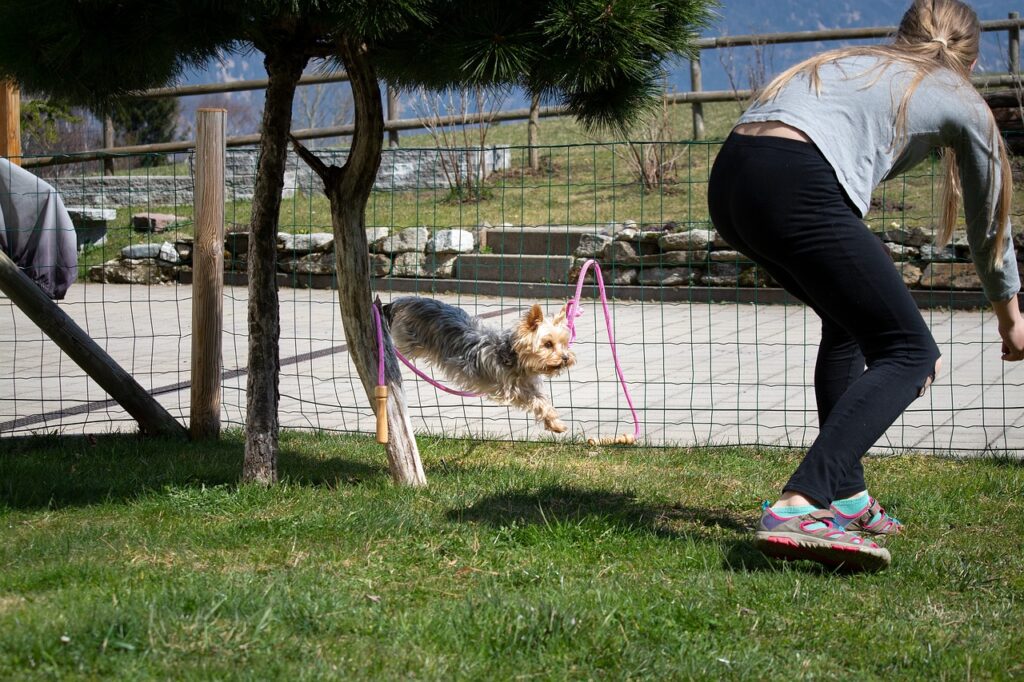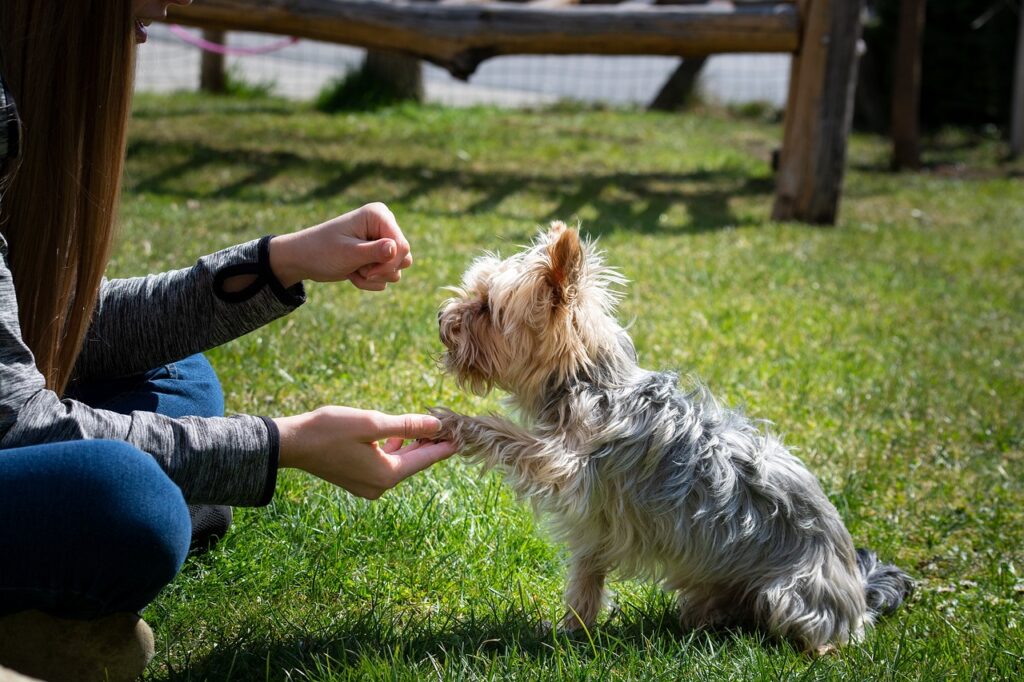Dog clicker training is a positive reinforcement training method that uses a clicker as a marker to communicate with the dog. The clicker is a small handheld device that makes a distinct clicking sound when pressed. This sound is used to signal to the dog that they have performed the desired behavior correctly. Clicker training has gained popularity in recent years due to its effectiveness and humane approach to training.
One of the reasons why clicker training is becoming increasingly popular is because it focuses on rewarding desired behaviors rather than punishing unwanted behaviors. This positive reinforcement approach creates a positive and enjoyable learning experience for both the dog and the owner. It also helps to build a strong bond between the dog and their owner, as it encourages trust and cooperation.
Key Takeaways
- Clicker training is a positive reinforcement method that uses a clicker to mark desired behaviors in dogs.
- Clicker training can improve communication and strengthen the bond between dogs and their owners.
- The science behind clicker training involves the principles of operant conditioning and shaping.
- Choosing the right clicker for your dog depends on factors such as sound, size, and ease of use.
- Timing and consistency are crucial in clicker training, and common mistakes to avoid include using the clicker as a bribe or punishment.
Understanding the Basics of Clicker Training for Dogs
Clicker training works by associating the sound of the clicker with a reward. When the dog performs a desired behavior, such as sitting or lying down, the owner clicks the clicker and immediately follows it with a treat or praise. This creates a positive association in the dog’s mind between the clicker sound and the reward, reinforcing the behavior.
Positive reinforcement is a key component of clicker training. By rewarding the dog for performing the desired behavior, they are more likely to repeat it in the future. This method focuses on rewarding good behavior rather than punishing bad behavior, which helps to create a positive and enjoyable learning experience for both the dog and their owner.
Timing and consistency are also crucial in clicker training. The click must be timed precisely to mark the exact moment when the dog performs the desired behavior. This allows the dog to understand which behavior is being rewarded. Consistency is important because it helps to reinforce the association between the clicker sound and the reward. The more consistent you are with your timing and rewards, the faster your dog will learn.
Benefits of Clicker Training for Dogs
One of the main benefits of clicker training is that it builds a strong bond between the dog and their owner. By using positive reinforcement, the dog learns to trust and rely on their owner for guidance and rewards. This creates a positive and enjoyable training experience for both the dog and their owner, strengthening their relationship.
Clicker training also helps to increase the dog’s confidence and self-esteem. When the dog realizes that they can earn rewards by performing certain behaviors, they become more confident in their abilities. This can have a positive impact on their overall behavior and well-being.
Another benefit of clicker training is that it helps to eliminate unwanted behaviors. By focusing on rewarding desired behaviors, the dog learns what is expected of them and is more likely to repeat those behaviors in the future. This can help to reduce or eliminate behaviors such as jumping, barking, and biting.
How Clicker Training Works: The Science behind It
Clicker training is based on the principles of classical conditioning and positive reinforcement. Classical conditioning is the process of associating a neutral stimulus (in this case, the clicker sound) with a meaningful stimulus (the reward). Over time, the neutral stimulus becomes a conditioned stimulus that elicits a response from the dog.
Positive reinforcement involves rewarding the dog for performing the desired behavior. When the dog hears the clicker sound, they know that they have performed the behavior correctly and will receive a reward. This creates a positive association in the dog’s mind between the clicker sound and the reward, reinforcing the behavior.
Clicker training also affects the dog’s brain by stimulating the release of dopamine, a neurotransmitter associated with pleasure and reward. When the dog hears the clicker sound and receives a reward, dopamine is released in their brain, creating a positive and enjoyable experience. This reinforces the behavior and encourages the dog to repeat it in the future.
Choosing the Right Clicker for Your Dog
There are different types of clickers available, including box clickers, button clickers, and whistle clickers. The type of clicker you choose will depend on your personal preference and what works best for your dog.
When choosing a clicker, there are several factors to consider. Firstly, you want to choose a clicker that is comfortable to hold and easy to use. It should fit comfortably in your hand and have a clear and distinct clicking sound.
It is also important to introduce the clicker to your dog properly. Start by clicking the clicker and immediately following it with a treat or praise. This helps the dog to understand that the clicker sound means they have done something right and will be rewarded. Repeat this process several times until the dog associates the clicker sound with a reward.
The Importance of Timing and Consistency in Clicker Training
Timing is crucial in clicker training because it allows the dog to understand which behavior is being rewarded. The click must be timed precisely to mark the exact moment when the dog performs the desired behavior. If the click is delayed or too early, it can confuse the dog and make it harder for them to understand what they are being rewarded for.
Consistency is also important in clicker training. The more consistent you are with your timing and rewards, the faster your dog will learn. If you are inconsistent with your rewards or only reward the behavior sometimes, it can confuse the dog and make it harder for them to understand what is expected of them.
Repetition is another key aspect of clicker training. Dogs learn through repetition, so it is important to practice the desired behaviors regularly. This helps to reinforce the association between the clicker sound and the reward, making it easier for the dog to understand what is expected of them.
Common Mistakes to Avoid in Clicker Training
One common mistake in clicker training is using the clicker as a punishment. The clicker should always be associated with a reward, not a punishment. Using the clicker as a punishment can confuse the dog and make them fearful or anxious.
Another common mistake is inconsistent training. If you are inconsistent with your rewards or only reward the behavior sometimes, it can confuse the dog and make it harder for them to understand what is expected of them. It is important to be consistent with your timing and rewards to ensure that the dog understands what is being rewarded.
Not rewarding the dog immediately after the click is another common mistake. The clicker sound should always be followed immediately by a reward. If there is a delay between the click and the reward, it can confuse the dog and make it harder for them to understand what they are being rewarded for.
Clicker Training vs. Traditional Training: What’s the Difference?
The main difference between clicker training and traditional training is the use of positive reinforcement. Clicker training focuses on rewarding desired behaviors, while traditional training often relies on punishment or correction to eliminate unwanted behaviors.
Clicker training has several benefits over traditional training. Firstly, it creates a positive and enjoyable learning experience for both the dog and their owner. By focusing on rewarding good behavior, it helps to build a strong bond between the dog and their owner.
Clicker training also allows for more precise communication between the dog and their owner. The clicker sound acts as a marker to signal to the dog that they have performed the desired behavior correctly. This makes it easier for the dog to understand what is expected of them and speeds up the learning process.
However, there may be situations where traditional training methods are more appropriate. For example, if a dog is displaying aggressive behavior, it may be necessary to use corrective measures to ensure the safety of both the dog and those around them. It is important to assess each situation individually and choose the training method that is most suitable.
Clicker Training for Different Types of Dogs and Behaviors
Clicker training can be used for dogs of all ages and breeds. It is a versatile training method that can be adapted to suit the individual needs of each dog.
For puppies, clicker training can be used to teach basic commands such as sit, stay, and come. It is important to start with simple commands and gradually increase the difficulty as the puppy progresses. Clicker training can also be used to socialize puppies and teach them appropriate behavior around other dogs and people.
Clicker training can also be used for adult dogs. It can help to reinforce good behavior and eliminate unwanted behaviors such as jumping, barking, and biting. Clicker training can also be used to teach more advanced commands and tricks.
For specific behaviors such as barking, jumping, and biting, clicker training can be used to redirect the dog’s behavior and teach them more appropriate alternatives. For example, if a dog jumps on people when they enter the house, the owner can use clicker training to teach the dog to sit instead.
Tips for Successful Clicker Training with Your Dog
To ensure successful clicker training with your dog, it is important to follow these tips:
1. Start with simple commands: Begin by teaching your dog simple commands such as sit or lie down. Once they have mastered these commands, you can move on to more advanced behaviors.
2. Keep training sessions short and frequent: Dogs have short attention spans, so it is important to keep training sessions short and frequent. Aim for 5-10 minute sessions several times a day.
3. Be patient and consistent: Training takes time and patience. Be consistent with your timing and rewards, and remember to reward your dog immediately after the click.
4. Celebrate your dog’s successes: When your dog performs a behavior correctly, celebrate their success with praise and rewards. This helps to reinforce the behavior and encourages them to repeat it in the future.
Clicker training is a positive reinforcement training method that uses a clicker as a marker to communicate with the dog. It is becoming increasingly popular due to its effectiveness and humane approach to training. Clicker training builds a strong bond between the dog and their owner, increases the dog’s confidence and self-esteem, and helps to eliminate unwanted behaviors.
Clicker training works by associating the sound of the clicker with a reward. Positive reinforcement is used to reward the dog for performing the desired behavior. Timing and consistency are crucial in clicker training, as they help the dog understand which behavior is being rewarded.
Choosing the right clicker for your dog and introducing it properly are important steps in clicker training. It is also important to be patient, consistent, and celebrate your dog’s successes. Clicker training differs from traditional training methods in its focus on positive reinforcement. It can be used for dogs of all ages and breeds and can be adapted to suit different behaviors.
If you’re interested in dog training, you may also want to check out this article on “How to Crate Train a Puppy at Night: The Moonlit Guide to Peaceful Evenings.” Crate training is an essential skill for puppies, and this guide provides helpful tips and techniques to ensure your puppy feels safe and comfortable in their crate during nighttime. (source)



